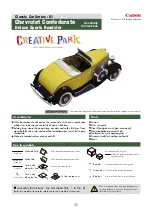
34
7. Notes on Batteries and Rechargeable Batteries
Despite the fact that handling batteries and rechargeable batteries in daily life nowadays is a matter of fact,
there are still numerous dangers and problems involved.
Ensure that you observe the following general information and safety information when handling batteries
and rechargeable batteries.
• Keep batteries/rechargeable batteries out of the reach of children.
• Do not leave any batteries/rechargeable batteries lying around openly. There is a risk of batteries being swallowed
by children or pets. In this case, see a doctor immediately!
• Batteries/rechargeable batteries must never be short-circuited, disassembled or thrown into fire. There is a danger
of explosion!
• Leaking or damaged batteries/rechargeable batteries can cause chemical burns to skin. Wear suitable protective
gloves when handling them.
• Do not recharge normal batteries. There is a risk of fire and explosion! Only charge rechargeable batteries (1.2 V)
intended for this purpose. Use suitable battery chargers. Batteries (1.5 V) are meant to be used once only and must
be properly disposed of when empty.
• Always observe the correct polarity when inserting batteries or connecting the charger (observe plus/+ and
minus/-). Wrong polarity may not only damage the transmitter, flight model and the rechargeable batteries. There is
a risk of fire and explosion.
• Always replace the whole set of batteries. Do not mix full batteries with half-full ones. Always use batteries/rechargeable
batteries of the same type and manufacturer.
• Never mix batteries and rechargeable batteries! Therefore, only use batteries for the remote control transmitter.
• If the device is not used for a extended period of time (e.g. storage), remove the inserted batteries from the remote
control to avoid damage from leaking batteries.
Attention!
After the flight, disconnect the flight battery from the helicopter. Do not leave the rechargeable flight battery
connected to the helicopter if the model is not used (e.g. during transport or storage). Otherwise, the flight
battery may be fully discharged and is thus destroyed/unusable!
• Never charge the enclosed flight battery immediately after use. Always let the flight battery to cool down until it has
reached room or ambient temperature again.
• Only charge intact and undamaged flight batteries. If the external insulation of the rechargeable battery is damaged
or if the rechargeable battery is deformed or bloated, it must not be charged. In this case, there is immediate danger
of fire and explosion!
• Never damage the flight battery covering, do not cut the foil cover, do not probe the rechargeable battery with sharp
objects. There is a risk of fire and explosion!
• To charge the flight battery, remove it from the model and place it on a fire-proof surface. Never recharge the flight
rechargeable battery unattended.
• Disconnect the flight battery from the charger (remote control transmitter/USB cable) when it is fully charged.
Содержание Micro
Страница 110: ...110 ...
Страница 111: ...111 ...
















































